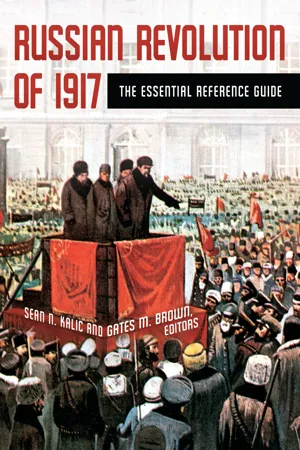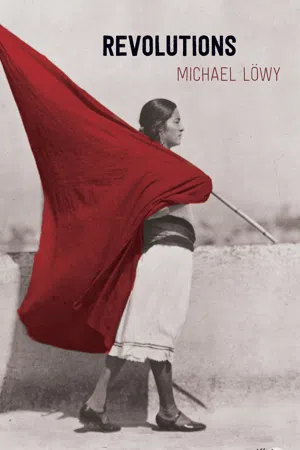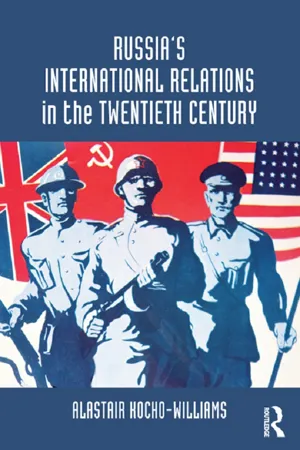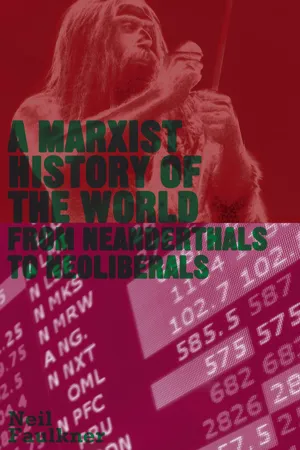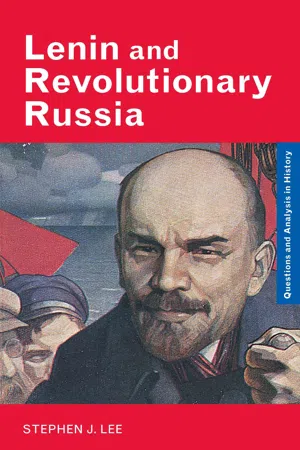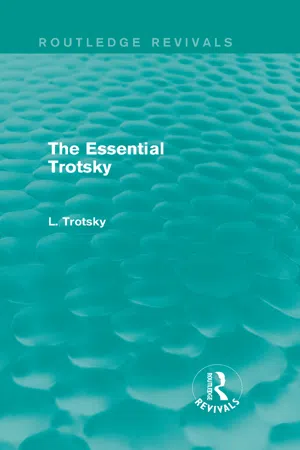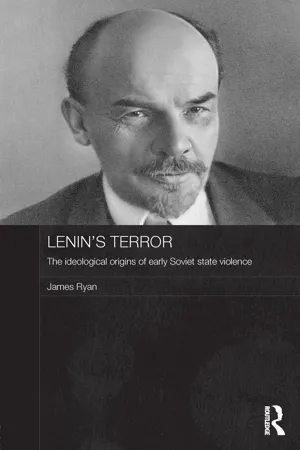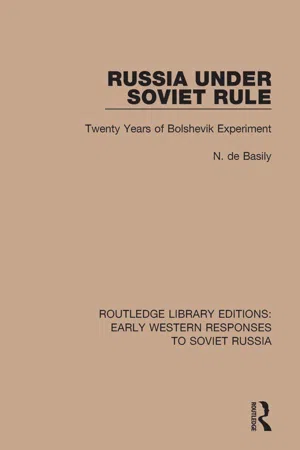History
Russian Revolution of 1917
The Russian Revolution of 1917 was a period of political and social upheaval in Russia, resulting in the overthrow of the Tsarist autocracy and the eventual establishment of the Soviet Union. It was marked by a series of events, including the February Revolution and the October Revolution, which led to the rise of the Bolsheviks and the end of the Romanov dynasty.
Written by Perlego with AI-assistance
Related key terms
12 Key excerpts on "Russian Revolution of 1917"
- eBook - ePub
Russian Revolution of 1917
The Essential Reference Guide
- Sean N. Kalic, Gates M. Brown(Authors)
- 2017(Publication Date)
- ABC-CLIO(Publisher)
The consequences of the Russian Revolution of 1905 therefore vary depending on the political perspective. In the context of the Bolshevik Revolution of 1917, the events of 1905 demonstrated that the Social Democrats were indeed tapping into a momentous popular position that gained support with each repressive action from the tsar. The events of 1905 for the Bolsheviks and Mensheviks highlighted the need to continue work for the eventual proletarian revolution. Furthermore, interpreting events within the context of Karl Marx, minor political and social adjustments by the tsar did nothing to alter the corrupt system. Violence and revolution stood as the only means for real change in the corrupt and oppressive regime of the tsar.The year 1905 therefore provided the Bolsheviks with keen insights and experiences from which they could learn and adapt for the eventual collapse of the tsar and his empire. Though they would suffer harsh repression and exile in the 12 years between the events of 1905 and the heady days of October 1917, the events throughout 1905 served their cause, and their agenda did indeed forever alter the regime of Tsar Nicholas II. Yet, more work had to be done in order to foster additional support throughout Russia for the Bolshevik cause. The tensions that existed in 1905 would only be magnified as Russia entered World War I, and by 1917 the conditions between March and October provided the Bolsheviks with the opportunity they had wanted in 1905: the end of the tsar’s empire.Sean N. Kalic The 1917 RevolutionThe Russian Revolution of 1917 occurred in two stages. There was the February Revolution, which overthrew the tsar’s regime and resulted in the Provisional Government, and then the October Revolution, which established the Bolsheviks as the governing power over what became the Soviet Union. These two movements differed in their scale of popular support and the ideologies that drove the primary actors. The February Revolution was not a long-planned social movement. Rather, it was a spontaneous reaction to unrest. It brought together myriad political parties and classes to overthrow Tsar Nicholas II and the Romanov monarchy. Due to the differences in the political objectives of the participants, there was not a clear plan for establishing the state to follow each of these significant revolutions. Some wanted to maintain a constitutional monarchy, others sought a democratic government, and some groups aimed to leverage this into an opportunity to start a worldwide socialist revolution. These diverging hopes and political objectives frustrated efforts of the Provisional Government to build a stable base of power to unify Russia under its authority. - eBook - ePub
- Michael Löwy(Author)
- 2020(Publication Date)
- Haymarket Books(Publisher)
1917
The Russian Revolution
Rebecca Houzel and Enzo TraversoThe Russian Revolution (1917)
S oviet Russia valued the image, locating it at the center of its system of representation and transforming it into one of the pillars of the socialist order. Statues, iconography, and design privileged symbols and myths. More than ninety years later, the 1917 Revolution’s aura still resonates to a considerable degree, even if its meaning has suffered a radical inversion by the dominant trends of public opinion: in contrast to 1789, October has been converted into a date marking the birth of totalitarianism. Returning to the images from the critical year of 1917, from the fall of the tsarist regime in February to the seizure of the Winter Palace in October eight months later, may have a salutary effect. Examining these fragments in time and analyzing the instants that constitute history helps us revisit the events themselves and allows us to strip away a thick layer of retrospective projections, first hagiography and later demonization.The only figure who escaped these memory wars, at least until a relatively recent period, was Tsar Nicholas II. He was absent from St. Petersburg at the moment of the February uprising, leading to an underestimation of his importance. Unaware of the dynamic of events, he was finally forced to abdicate. It was a surprising and sudden collapse following the bloody repression from which it sprang. One celebrated photograph, dated from early 1917, in which Nicholas is surrounded by his family, including his wife Alexandra and his five children, became a symbol of the ancien régime. A strange impression of calm, of tranquil assurance, almost confidence, radiates from the figures. There is no trace of worry darkening the tsar’s face, nothing that allows us to foresee the upheavals that will annihilate him and his family some months later. Another photo shows him in military uniform, walking alongside an imperial train. He does not know that he will soon sign his abdication decree in this very same place. He appears alone, beside the train that has stopped in the middle of the countryside. The conductor waits for him, observing him through a glass door; the tsar represents no one but himself. His execution, in July 1918, would mark a point of no return. Yet, except among a minority of the exiled aristocracy, his death would not produce the same commotion that swept through Europe after the decapitation of Louis XVI. Nicholas II would not inspire an Edmund Burke or a Joseph de Maistre to idealize his legacy and celebrate his memory. This may be the reason why he never appears to us in a tragic light in these antiquated records; instead, he looks like a piece in a museum. - Alastair Kocho-Williams(Author)
- 2013(Publication Date)
- Routledge(Publisher)
2 The Russian revolutions of 1917 and the Russian Civil War in international context
In February 1917 (OS) Russia underwent the first of two revolutions that year. The Tsar had lost control of his capital, and with military failure and supply shortages on the home front, Petrograd erupted into revolution. The Tsar abdicated, to be replaced by a Provisional Government, which was in turn swept aside in October 1917 in a Bolshevik-led coup. Both revolutions resonated internationally, and provoked responses from foreign governments.The two revolutions had different characteristics, both domestically and in terms of how they affected Russia’s relations with foreign powers. While the Provisional Government showed a commitment to the continuance of Russian involvement in the First World War, the Bolsheviks did not. While the February Revolution put Russia onto a democratic path in the eyes if its international partners, the Bolshevik Revolution led to a new, revolutionary regime that rejected diplomacy as a bourgeois practice and believed that a new era of revolutions would sweep over the globe.Beyond the revolutions, it is important to consider the international reactions to them. The new Soviet regime threw down a challenge on the global stage. Initial reactions were to hope that it would collapse, but when this failed to occur and Russia entered a period of civil war, the Russian Empire’s former allies intervened against the Bolsheviks in the Russian Civil War. This chapter will consider the international context of the Russian revolutions of 1917 and the Russian Civil War, and the development of the Soviets as an international power in the revolutionary period.The February Revolution and the world
The February Revolution began with the outbreak of unrest in Petrograd on 23 February 1917 (OS). Women workers protesting at food shortages directly challenged the regime, and protests grew. By the following day, Petrograd had been flooded with protestors, and when orders were given to the army to use force against the crowds on 26 February, it mutinied and began to go over to the side of the revolution. This was decisive, and the regime lost control of the capital of the Russian Empire. On 27 February, the bulk of the Tsar’s ministers were arrested, while Nicholas II set out to return to Petrograd from the front. On his arrival, the Tsar was advised to abdicate the throne. Following this advice, he abdicated on 2 March 1917, also abdicating for his son, the Tsarevich Alexei, who, as a haemophiliac, was not considered well enough to occupy the throne. Instead the imperial crown was offered to the Tsar’s brother, Grand Duke Mikhail, who duly refused to accept it and commanded the Russian people to obey the newly established Provisional Government. Nicholas II, now known as Nicholas Romanov, was placed under house arrest with his family at Tsarskoe Selo. With little resistance, the Russian Empire came to an end.- eBook - ePub
Revolution, Democracy, Socialism
Selected Writings of V. I. Lenin
- V. I. Lenin, Paul Le Blanc(Authors)
- 2008(Publication Date)
- Pluto Press(Publisher)
71917 REVOLUTION
In February/March 1917, beginning with an uprising initiated by radicalising women workers on International Women’s Day, a mass working-class insurgency demanding peace, freedom, and social justice overwhelmed the authorities of St Petersburg, was joined by troops (largely peasants in uniform) brought in to quell the crowds, and culminated in the forced abdication of Tsar Nicholas II and the collapse of the Russian monarchy, amid popular jubilation throughout the country. In the course of these events, soviets (democratic councils) once again arose in the working-class districts, at the same time many traditional politicians rallied – in part to stave off further radicalisation – to form a Provisional Government which promised to take matters in hand, organise elections for a Constituent Assembly (that would write a constitution for a democratic republic), and bring the revolution to a harmonious conclusion.The Provisional Government contained elements from the upper classes, moderate conservatives and liberals, plus moderate socialists tied to the Socialist-Revolutionary Party (SRs) and Mensheviks. Despite anti-war sentiment, the Provisional Government was inclined to maintain Russia’s involvement in the First World War. Despite the land hunger of the peasants, the Provisional Government was not inclined to confiscate and redistribute the land that was concentrated in the hands of the nobility. Despite terrible shortages of bread and other foodstuffs in the cities, the policies of the Provisional Government were unable to eliminate the causes of this problem (particularly the devastation of the war). When Lenin returned to Russia in April 1917, he presented at meetings of Bolsheviks and of all left-wing parties his ‘April Theses’ calling for a working-class revolution, supported by the peasantry, that would give all political power to the soviets and move forward to socialism. - eBook - ePub
Reconstructing Lenin
An Intellectual Biography
- Tamás Krausz, Balint Bethlenfalvy(Authors)
- 2015(Publication Date)
- Monthly Review Press(Publisher)
Chronology of Russian History1917–1924
1917
JANUARY–FEBRUARY: Food and fuel shortages in the capital. Continuous strikes and protests against the war and autocracy to improve living conditions.23 FEBRUARY (8 MARCH): Thousands march on the streets of Petrograd: hunger strike on International Women’s Day; the march turns into a general strike. The second Russian revolution begins: the monarchy will be overthrown; the soviets will be formed again.27 FEBRUARY (12 MARCH): Tsar Nikolay II dissolves the Duma and orders disturbances suppressed. Duma stays together. In Taurian Palace the Petrograd Soviet of Workers is formed under Menshevik and SR influence; its leader is the Menshevik Nikolay Cheidze, deputies are Trudovik Aleksandr Kerensky and the Menshevik Matvey Skobelev.28 FEBRUARY (13 MARCH): The Provisional Committee of Duma announces that it will take power. The ministers of the tsarist government are discharged.2 MARCH (15 MARCH): In his special train at the Pskov railway station Tsar Nikolay II receives the deputies of the Duma: the Octobrist Aleksandr Guchkov and the monarchist Vasily Shulgin. At their request he abdicates in favor of the Grand Duke Mikhail. The Provisional Government is formed; it is led by the Kadet Prince Georgy Lvov, who will also take the post of Minister of Interior—among the members are the Kadet Pavel Miliukov as Minister of Foreign Affairs, the Octobrist Aleksandr Guchkov, Minister of War, the Trudovik Aleksandr Kerensky as Minister of War, etc. This event is the beginning of the “double power” of the bourgeois government and the Socialist Petrograd Soviet (with a Menshevik–SR majority). The Grand Duke Mikhail abdicates the same day.4 MARCH (17 MARCH): - eBook - ePub
National Identity and Great-Power Status in Russia and Japan
Non-Western Challengers to the Liberal International Order
- Tadashi Anno(Author)
- 2018(Publication Date)
- Routledge(Publisher)
In asserting Russia’s leading role in the revolutionary process, Leninism replicated, with or without intention, a pattern characteristic to Russian definitions of national identities since the mid-nineteenth century. Comparing Russia and the West, Leninism by implication proclaimed the superiority of revolutionary, Soviet Russia to the decadent, capitalist West. The claim of Russia’s superiority, however, was couched in a language borrowed from the Western enlightenment tradition and Marxist theory. Russia was extolled not as a unique civilization fundamentally different from the West, but as a “superior West” which shows an example for the West to follow. Faced with the crisis of international order, the Bolsheviks did not turn their back on Europe; rather, they sought to make their voice heard in the center of European civilization. In this sense, the Bolshevik Revolution fulfilled Michelet’s prophesy 66 years earlier. Russia now said, “I am socialism.”The changing international environment and Bolshevik responses
In October 1917, the Bolsheviks set out to revolutionize the world. If “world revolution” was an overstatement, they certainly expected that the revolution would spread to advanced European countries. Integration with revolutionary Europe was considered an essential prerequisite for the victory of socialism in Russia. Triumph of the revolution on a European scale, or defeat at the hands of the whites, assisted by the international bourgeoisie? These were the stark alternatives posed by the Bolsheviks in 1917. However, by the mid-1920s, it was evident that this formula had lost its validity. What happened since 1917 was surprising in two ways. Not only did European revolution fail to materialize, but also despite this failure, the Soviet regime weathered immediate threats to its existence (Uldricks 1979, 60). How were they to respond to this new situation? Naturally, the Bolsheviks were not inclined to relinquish power simply because their prediction proved incorrect. They had to find a new pathway to socialism. Views on how to proceed diverged on two major issues: (1) revolutionary radicalism versus gradualism (in domestic and external policy), and (2) political, economic, and cultural integration with Europe versus isolationism.First, the Bolsheviks were unsure at what speed they should press forward toward socialism. When the radical policies of “War Communism” between 1918 and 1921 resulted in widespread revolts against the regime, the Bolsheviks were compelled to settle on a gradualist policy known as the New Economic Policy (NEP), which involved tolerance of small-scale capitalism as well as conciliatory policy toward the peasant population. But was NEP the right path to follow in the long run? Did NEP and peaceful coexistence with the capitalist powers constitute a realistic, constructive strategy of building socialism? Or was it a temporary and forced retreat, which has to be abandoned whenever the conditions for a new “socialist offensive” ripen? Lenin seemed to give qualified support to the gradualist approach before his death in January 1924. However, advocates of radical approach could also cite Lenin’s statements in their support. - eBook - ePub
A Marxist History of the World
From Neanderthals to Neoliberals
- Neil Faulkner(Author)
- 2013(Publication Date)
- Pluto Press(Publisher)
Aurora and unable to prevent armed workers and sailors infiltrating the palace’s labyrinth of entrances and passageways, the defence crumbled amid frantic scuffles. It would all look far more impressive in Eisenstein’s 1927 film of the event.On the evening of 25 October, Trotsky reported to the Petrograd Soviet that ‘the Provisional Government has ceased to exist’. Lenin emerged from hiding to announce ‘a new era in the history of Russia’. ‘We have the strength of a mass organisation which will triumph over everything and bring the proletariat to world revolution,’ he continued. ‘In Russia, we must proceed at once to the construction of a proletarian socialist state. Long live the worldwide socialist revolution!’The radicalism of the new government was without precedent. A decree on land transferred the property of the landlords to millions of peasants. A decree on industry gave the workers control of the factories. A decree on self-determination gave the oppressed nations of the Russian Empire the right to independence. The mansions of the rich were taken over to house the poor. Equal access to education and health care became the right of every citizen. Marriage and divorce laws were swept away, equality between the sexes became mandatory, and adultery, homosexuality, and abortion were decriminalised.Nothing like this had ever happened before. Most previous revolutions, even in their most radical phases, had remained under bourgeois control. The major exception, the Paris Commune of 1871, had been restricted to one city and lasted only two months. Now, for the first time in history, the working class had taken power in a modern nation-state.The preceding eight months of the revolution had been the necessary preparation. The ebbs and flows of the struggle – the rhythms of the revolution – had been an essential process of learning for the masses, of shedding illusions, of gaining confidence, and of moving to the left through the hard knocks of political experience. The dual power – the mechanics of the revolution – had given organisational expression to the escalating confrontation of social forces, the Provisional Government becoming the rallying point for all the forces of reaction, the soviets embodying the growing consciousness and will of the masses. The Bolsheviks – the party of the revolution – had provided the vital network of embedded rank-and-file activists able to give direction to the struggle at every level. - eBook - ePub
- Stephen J. Lee(Author)
- 2008(Publication Date)
- Routledge(Publisher)
The period between 1905 and 1914 saw a number of major changes in Tsarist Russia. A constitutional experiment began in 1906 with the establishment of a new state duma and the legalisation of political parties. The economy expanded rapidly and Stolypin’s agricultural reforms had the clear intention of creating a wealthy upper stratum of peasants who would provide social stability. Although there were also powerful political and social tensions, created at least in part by the Tsar’s attempt to reassert autocracy, this was not a happy period for the Bolsheviks. The split with the Mensheviks widened and became permanent, and the period to 1914 was taken up with bitter recrimination between the two groups. Although the Bolsheviks claimed the credit for widespread strike action in 1912 and 1913, there is considerable evidence that this was largely spontaneous; the influence of the Bolsheviks was, to say the least, questionable.Russia’s involvement in the First World War destabilised the whole Tsarist system. This was due largely to early military reverses at the hands of the Germans and the decision made by Nicholas II to leave Petrograd to take over the command of the armed forces in 1915. The resulting power vacuum at the centre of the regime was filled by the Tsarina Alexandra and Rasputin who, between them, managed to antagonise vir tually every class, sector and interest in Russia. This was particularly productive for the various revolutionary groups, who sought to take full advantage of the regime’s predicament. However, co-operation between them was another matter. The Bolsheviks kept strictly to their own devices and Lenin was in exile in Switzerland until April 1917. - eBook - ePub
- Leon Trotsky(Author)
- 2014(Publication Date)
- Routledge(Publisher)
The Russian Revolution
DOI: 10.4324/9781315794556-3Events at the present time succeed one another so rapidly that it is difficult to reproduce them from memory even in their simple chronological order. I have no papers or documents at hand. At the same time the periodical breaks in the negotiations at Brest-Litovsk give me a certain amount of leisure which, under present conditions, is not likely to recur. I shall, therefore, try to sketch from memory the course and development of the November Revolution, reserving to myself the right to complete and correct my narrative at some future date, with the aid of documentary evidence.What distinguished our party almost from the very first stage of the Revolution was the firm conviction that the logic of events would eventually place it in power. I am not speaking here of the theoreticians of our party, who, many years before the Revolution, even before the Revolution of 1905, had come to the conclusion, from a close analysis of the class relations in Russia, that the victorious course of a revolution would inevitably place the power of the State in the hands of the proletariat, supported by the wide masses of the poorest peasantry. The main foundation for this belief was the insignificance of the Russian middle-class democracy and the concentrated character of Russian industry, and, therefore, the immense social importance of the Russian working class. The insignificance of the Russian middle-class democracy is but the obverse side of the power and importance of the proletariat. True, the war temporarily deceived many people on this point, and, above all, it deceived the leading sections of middle-class democracy itself. The war assigned the decisive role in the Revolution to the army, and the old army was the peasantry. - eBook - ePub
Lenin's Terror
The Ideological Origins of Early Soviet State Violence
- James Ryan(Author)
- 2012(Publication Date)
- Routledge(Publisher)
1‘Revolution is war’
The genesis of a militant Marxism, 1894–19071The proletariat will learn the art of civil war, now that it has started the revolution. Revolution is war. Of all the wars known in history it is the only lawful, rightful, just, and truly great war.2(V.I. Lenin, 1905)On Sunday 9 January 1905 a peaceful procession for economic and political reforms was fired upon by the Tsar’s troops in St Petersburg, resulting in at least 130 deaths. In the aftermath of ‘Bloody Sunday’, popular confidence in the Tsar was severely tested and a wave of strikes spread across the industrial centres of the country, accompanied by unrest and revolts in the countryside and widespread, multifarious forms of violence. In 1905 alone over 3,000 government officials were killed or wounded.3 Russia had entered a time of revolutionary upheaval.4 For Lenin, the news arriving from Russia to his place of exile in Geneva convinced him that the time had finally arrived for the Russian empire to undergo that stage in Marxist theory known as the bourgeois-democratic revolution. That is, the overthrow of the autocracy (and by extension the monarchy), the convocation of a representative people’s assembly, and the procurement of widespread civil liberties. In short, it was supposed to be Russia’s 1789.Popular unrest, including amongst the liberal-minded middle classes, had been developing across the empire and become particularly apparent in 1904 during Russia’s humiliating war with Japan. The conciliatory measures that the government made only served to embolden calls for change. The Tsarist regime was ruled autocratically – that is absolutely, without constitutional and parliamentary restraint – by Tsar Nikolai (Nicholas) II, and was considered by contemporary progressive thinkers the most backward, reactionary and oppressive of European powers. It was not willing to accommodate politically the modernizing processes that Russia had entered upon since the latter part of the nineteenth century, especially since the industrialization drive begun in the late 1880s, though the peasant unrest in 1905 may well have been largely in reaction to these modernizing processes.5 This was, as John Keep notes, a time when progressive elements of society generally ‘considered that violence was a natural, justified response to a brutal and repressive autocratic regime’,6 - eBook - ePub
After Empire
Nationalist Imagination and Symbolic Politics in Russia and Eurasia in the Twentieth and Twenty-First Century
- Igor Torbakov(Author)
- 2018(Publication Date)
- Ibidem Press(Publisher)
54October in the Post-Communist Era
1997
“No one cares much any more” about celebrating the anniversary of October in post-Soviet Russia, Martin Malia noted with unmistakable satisfaction soon after the USSR’s implosion.55 Indeed, the meaning of the Russian Revolution was radically reinterpreted within the official discourse of the militantly anticommunist Yeltsin regime. A historic event that over the previous 74 years was regarded as one that ushered in the “new world” and made Russia the vanguard of humankind, was now portrayed as national catastrophe that derailed the country from the path of “normal” historical development.56 The anticommunist attitudes that were dominant among Russia’s new governing elites, however, did not prevent certain political ideals associated with the myth of October from remaining popular among Russia’s “new lower classes” that emerged from under the rubble of radical economic reforms of the early 1990s. These underdogs became the main political base for the reemerged communist movement: in February 1992, its grassroots organizations in Russia came together and formed a new political association—the Communist Party of the Russian Federation (CPRF). Under new circumstances, Russia’s communists significantly revised their ideological toolkit. The CPRF sought to merge socialist and nationalists ideals, and its modernized political discourse upheld both proletarian internationalism and Russia’s great power status. The party’s leadership portrayed October as the triumph of Russia’s toiling masses but also as a crucial moment in the perennial civilizational confrontation between Russia and the West. The Revolution, they maintained, helped Russia escape an imminent colonization by Western powers and set it on the path of alternative modernity, distinct from the West’s.57 The CPRF soon became the core of “left opposition”—an alliance of leftwing and patriotic organizations—that acted as the principal political opponent of the “Yeltsin democrats.” Following the December 1993 elections, communists formed the largest faction in the State Duma and in 1996, one year prior to October’s 80th - eBook - ePub
Russia Under Soviet Role
Twenty Years of Bolshevik Experiment
- N. de Basily(Author)
- 2017(Publication Date)
- Routledge(Publisher)
CHAPTER IIThe Revolution of 1917
Suddenness of the RevolutionThe rapidity with which the Imperial régime collapsed in 1917 surprised even observers who saw the future dark with inevitable perturbations and considered that the monarchy would be held largely responsible for them.As early as August 1915 the internal difficulties and serious military complexities facing the country had caused within the Duma the formation of a “Progressive Bloc,” comprising the majority of the non-Socialist deputies, with the exception of those of the extreme Right. The Bloc constantly urged the creation of a Ministry enjoying general confidence. It regarded such a concession to public opinion as the sole means of successfully helping the State out of its perilous situation, and of conducting the armies to victory. The Government obstinately refused to listen to the stern warnings of the Bloc, thereby throwing its members into increasing opposition.Still, up to the Revolution of 1917, all the advanced Liberals and moderate Conservatives remained faithful to the principles which had led them to unite. Convinced and unanimous partisans of monarchy, they did their best to prevent the explosion of elementary forces. They had never been in favour of a revolution, which they dreaded in the middle of the war. In fact, they were conscious that an uprising, even were it suppressed, would deal a fatal blow to the country’s powers of resistance. As to the still more advanced parties, the Socialists, they had at the time of the declaration of war committed themselves by a great majority to support national defence, and did not wish to stand in the way of Russia’s being among the victors at the end of the world conflict.1 Besides, like everybody, they believed the Government to be much stronger than it subsequently proved to be. This was, for instance, the attitude of Chkheidze, a Social-Democrat and a member of the Duma, who became later on the president of that “Soviet of Workmen’s and Soldiers’ Deputies”1
Index pages curate the most relevant extracts from our library of academic textbooks. They’ve been created using an in-house natural language model (NLM), each adding context and meaning to key research topics.
